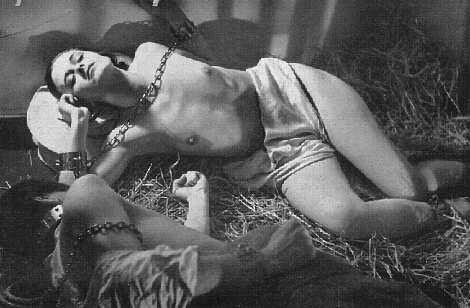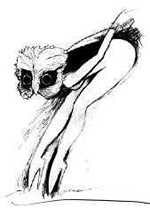THE ORIGINS OF O
o
"O is... little more than... a shadow that
murmers in the night." - Pauline Reage

I would like to share with you a set of photographs from a 1936 issue of PARIS Magazine which has been passed to me
as a "too good to be true" origin of Pauline Reage's STORY OF O. It is of course pure conjecture that such a sequence of
photographs in one slim volume may have inspired the writing of Histoire d'O but it is not unreasonable that this
magazine or booklets like it, may well have been amongst the collection of erotica that Pauline Reage/Dominique Aury
discovered in her father's library when she was in her mid- twenties and may well have served as a way forward when
Aury's lover Jean Paulhan whom she had first met in the early years of the war challenged her to write the novel she
had proposed.

Aury had been a voracious reader. She read Proust in the French, Shakespeare in the English, the Bible, Baudelaire, Villon,
her father's hidden editions of Boccaccio and Crebillon, Malherbe, Bertaut, the English Gothic writers, Fenelon's mystical
writings, and as a child religious manuals given by her aunt and devotional books illustrating the tortures of the martyred
saints. Aury did not however, read De Sade until after she had written Histoire d'O and in Confessions of O she maintains
that it was not only books that, "provoked my fantasies; my fantasies are much more autonomous... those underground tales
relate in a curious way to the fantasy world I created beneath the garden of the house I lived in as a little girl..."



"Another version of the same beginning was simpler, more direct: similarly dressed, the young woman was taken off in a car by her lover and by a second man, an unknown friend of his... and after about thirty minutes' drive, she was helped out of the car and marched a few steps..." ( from Story of O )



"He told her that, to begin with, she must not think of herself as free. From now on, that is to say, she was not free; or rather she
was free in on sense, only in one: to stop loving him and to leave him immediately. But if she did love him, if she was going to,
then she was not free at all..." ( from Story of O )


"From the first day, O had shared the life led in that house. a life of absolute and mandatory idleness relieved by monotonous
distractions. The girls were free to take walks in the garden, to read, to draw, to play cards... In the evening, Anne-Marie
designated one of them as her bed-companion for the night..." ( from Story of O )

o
( Many thanks to N for access to the above photos. Stefan July 2001 )
Artist Fini was the Owl in O

"a divine heroine straight out of Edgar Allan Poe" - Jean Cocteau

Fini and Her Masks
Buenos Aires born artist Leonor Fini (1918 - 1996), described by Carlos Lozano rather uncharitably as "an insatiable lesbian... a portrait of bondage in studs, chains and black leather', and known on the continent for her paintings of cats, was a heavily mascaraed beauty as feline as any of her subjects and a party animal who was the inspiration for the Owl Mask at the close of Story of O. Pauline Reage [Dominique Aury] writes of such in 'A Girl in Love' the preface to Retour a' Roissy;
"Nor did I make up - steal, rather, for which I ask her belated pardon,
but the theft was committed out of adoration - the Leonor Fini masks..."
This implies Aury knew Fini's work well though it is quite possible Aury also witnessed Fini as owl at some fancy dress party or knew Fini through their association with Paris publisher Jean-Jacques Pauvert - which ever, it is clear from a photograph taken of Fini in 1948 (above) that her owl costume existed prior to or at least during the writing of Histoire d'O. It was possibly the costume Julien Levy describes Fini wearing at a Surrealist Ball given by Tristan Zara for which the guests were instructed to appear nude only from chest to thigh.
The owl mask featured in Just Jeakin's movie Story of O is so obviously based upon that of Fini that one cannot but wonder if Fini had a hand in that too. Although there is no reason to assume either Aury or Fini were consulted by the film makers (Aury apparently thought the film well done but the acting awful) Fini's costume might well have been the obvious choice considering her reputation as a theatre costume designer.
Fini wore other masks - but as in the novel it is the owl that is chosen by Aury  - its associations with wisdom and death must surely have appealed to Aury who for some years hid behind her own 'mask' of anonymity. Aury's Reage 'mask' slipped finally towards the end of her life when her true identity was revealed as Anne Declos. Fini whose eroticism matches that of Histoire d'O in that it speaks of Thanatos and Eros is remembered as a beauty and a painter of beautiful and intelligent works. Her style was ideally suited to illustrate luxury editions of Story of O in the 1960s. Fini died in 1996.
- its associations with wisdom and death must surely have appealed to Aury who for some years hid behind her own 'mask' of anonymity. Aury's Reage 'mask' slipped finally towards the end of her life when her true identity was revealed as Anne Declos. Fini whose eroticism matches that of Histoire d'O in that it speaks of Thanatos and Eros is remembered as a beauty and a painter of beautiful and intelligent works. Her style was ideally suited to illustrate luxury editions of Story of O in the 1960s. Fini died in 1996.
Leonor Fini (Argentinian, 1908-1996)
Leonor Fini is one of the more international figures of the Surrealist movement. She was born in Argentina, raised in her mother's home town of Trieste, Italy, and spent most of her artistic life in Paris, where she had her first one-person show in 1935. Although she was friends with many of the leading surrealists (including Max Ernst and Victor Brauner), she never formally joined the movement though she did include her works in several of their International Surrealist Exhibitions. After the Second World War, she had many 1972). Although she is best known for her paintings, prints, and drawings, she also created stage designs for operas and ballets including one of her own, Le Rêve de Leonor (1949), which was choreographed by Sir Frederick Ashton and performed to music by Sir Benjamin Britten. Her obituary in the London Times stressed her physical beauty, her erotic art, and her legions of lovers, whose names "read like a roll call of the literary and artistic talents of that brilliant age." Fini's works are to be found in many important collections of modern art.
Bibliography:General works: Leonor Fini, Chats d'Atelier (France: Michèle Trinckvel, 1994); Leonor Fini et al, Leonor Fini (Paris: Galerie Dionne, 1997); Leonor Fini (Preface), Leonor Fini Peintures (France: Michèle Trinckvel, 1994); Jean Paul Guibbert, Leonor Fini: Graphique (France: Editions Clair Fontaine, 1976); Constantin Jelenski, Leonor Fini (London: The Olympia Press, 1968); Jean Paul Guibbert, Leonor Fini: Graphique (France: Editions Clair Fontaine, 1976).
A Note on OWLS:
from All the Birds of the Air by Francesca Greenoak (pub.1997)
BARN OWL: "All over the world owls are held to be creatures of magic and superstition... The Barn Owl, like most owls, is a creature of the night and for this reason associated with the powers of darkness. Witches were believed to depend greatly upon the owl-kind... Strange powers are often attributed to birds who in some way or another resemble human beings. The face of the Barn Owl, flat and pale, bears this similarity much more than the faces of other birds and its weird unearthly shriek has enough strangeness in it to unsettle even a sophisticated modern ear... Inhabiting ruins, it was by association believed to bring ruin, and from this it was an easy step to the Barn Owl's becoming in a more general way a creature of doom and death... The owl, like most birds of ancient symbolism could also assume a benign influence..." (also once known in Britain as: White Hoolet, Screech Owl, Billy Wise, Jenny Howlet and Hobby Owl)
LITTLE OWL: "In greek mythology, the Little Owl was the bird sacred to Pallas Athene, the goddess of wisdom, and it is from this that we derive the idea of the 'wise old owl'...
TAWNEY OWL: "Many of the beliefs and superstitions which seem to have originated with other owl species are accorded also to the Tawney Owl... it is nearly always attributed with wisdom..." (also known in Gaelic as Cailleach oidhche = old woman of the night)


'The Owl Mask' ( drawings by Stefan )
E-MAILS ON THE SUBJECT OF
THE OWL MASK
O
( 2004 ) Hi,
First of all, a word of praise for your excellent website.
However, I must disagree with you about the origin of the owl mask. You quote lots of evidence to show that Dominique Aury either knew Leonor Fini, or her work, but I would argue that if Mme Aury quoted Fini as an inspiration, she was being (for whatever reason) disingenuous.
I would suggest that there is a far more compelling argument to be made for Max Ernst's "Robing of the Bride" (1940) being the true inspiration for this weirdest of scenes in the book.
(http://www.abcgallery.com/E/ernst/ernst29.html)
Examine the picture, and make up your own mind, but (to me) the similarities are too striiking to be ignored - and I'm sure I can't be the first person to have spotted them.
Kindest regards PETE
"Last week I visited the Peggy Guggenheim Collection in Venice. I was really flabbergasted by Max Ernst's Attirement of the Bride (1940), see attachment. It is very easy to find information about the painting on the internet, see for instance http://www.guggenheim-venice.it/english/03_Collections/Images/Ernst_1940_Attirement.htm
In your own article about the origin of the owl mask you mention a connection between Leonor Fini and Max Ernst. The mask Fini was wearing at Tristan Zara's ball must have been inspired by this painting by Max Ernst.
But there is more! An important line of comment on the picture:
"The obscure subject matter has been interpreted in terms of a Rosicrucian initiation rite."
I don't know what 's the base of this remark, but I am sure somewhere in Story of O the Rosicrucian order is mentioned: I think where the uniforms of the Lovers of Roissy are described. I cannot find it in the English text and I don't have the French urtext in digital form, but I will try to find it. What do the Rosicrucians have to do with the origins of our favourite novel? This is a new question we can investigate."
O
Click Here> to Find the: LOST SCENE from Story of O
Return to Key ![]()